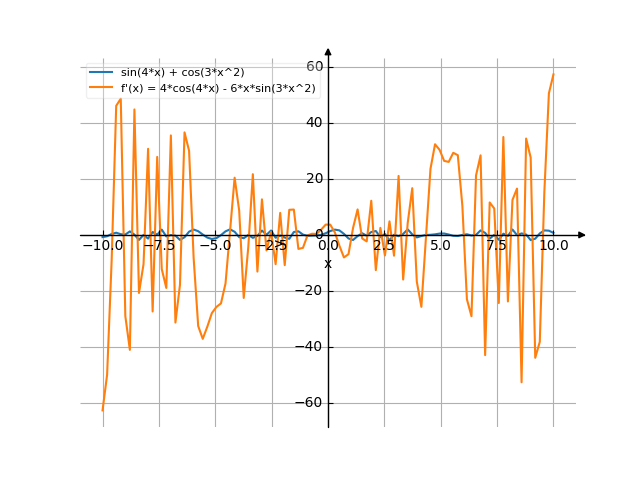Derivative of y=sin(4x)+cos(3x^2)
The solution
You have entered
[src]
/ 2\ sin(4*x) + cos\3*x /
$$\sin{\left(4 x \right)} + \cos{\left(3 x^{2} \right)}$$
d / / 2\\ --\sin(4*x) + cos\3*x // dx
$$\frac{d}{d x} \left(\sin{\left(4 x \right)} + \cos{\left(3 x^{2} \right)}\right)$$
Detail solution
-
Differentiate term by term:
-
Let .
-
The derivative of sine is cosine:
-
-
Then, apply the chain rule. Multiply by :
-
The derivative of a constant times a function is the constant times the derivative of the function.
-
Apply the power rule: goes to
So, the result is:
-
The result of the chain rule is:
-
-
Let .
-
The derivative of cosine is negative sine:
-
Then, apply the chain rule. Multiply by :
-
The derivative of a constant times a function is the constant times the derivative of the function.
-
Apply the power rule: goes to
So, the result is:
-
The result of the chain rule is:
-
The result is:
The answer is:
The first derivative
[src]
/ 2\ 4*cos(4*x) - 6*x*sin\3*x /
$$- 6 x \sin{\left(3 x^{2} \right)} + 4 \cos{\left(4 x \right)}$$
The second derivative
[src]
/ / 2\ 2 / 2\\ -2*\3*sin\3*x / + 8*sin(4*x) + 18*x *cos\3*x //
$$- 2 \cdot \left(18 x^{2} \cos{\left(3 x^{2} \right)} + 8 \sin{\left(4 x \right)} + 3 \sin{\left(3 x^{2} \right)}\right)$$
The third derivative
[src]
/ / 2\ 3 / 2\\ 4*\-16*cos(4*x) - 27*x*cos\3*x / + 54*x *sin\3*x //
$$4 \cdot \left(54 x^{3} \sin{\left(3 x^{2} \right)} - 27 x \cos{\left(3 x^{2} \right)} - 16 \cos{\left(4 x \right)}\right)$$
The graph


![Find the derivative of y' = f'(x) = y=sin(4x)+cos(3x²) (y equally sinus of (4x) plus co sinus of e of (3x squared)) - functions. Find the derivative of the function at the point. [THERE'S THE ANSWER!] y=sin(4x)+cos(3x^2)](/media/krcore-image-pods/176/hash/derivative/6/4a/c6f49b07e4942e4eca536a233c085.png)
 Derivative of x^-6
Derivative of x^-6
 Derivative of 3*(2-x)^6
Derivative of 3*(2-x)^6
 Derivative of -x^5+2*x^3-3*x^2-1
Derivative of -x^5+2*x^3-3*x^2-1
 Derivative of (x+2)/(x^2-9)
Derivative of (x+2)/(x^2-9)